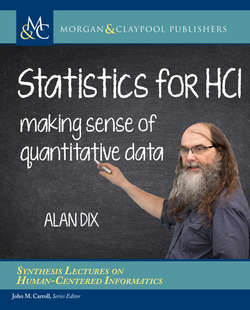Читать книгу Statistics for HCI - Alan Dix - Страница 7
На сайте Литреса книга снята с продажи.
ОглавлениеContents
Preface
Acknowledgments
1 Introduction
1.1 Why are probability and statistics so hard?
1.1.1 In two minds
1.1.2 Maths and more
1.2 Do you need stats at all?
1.3 The job of statistics –from the real world to measurement and back again
1.3.1 The ‘real’ world
1.3.2 There and back again
1.3.3 Noise and randomness
1.4 Why are you doing it?8
1.4.1 Empirical research
1.4.2 Software development
1.4.3 Parallels
1.5 What’s next
PART I Wild and Wide –Concerning Randomness and Distributions
2 The unexpected wildness of random
2.1 Experiments in randomness
2.1.1 Rainfall in Gheisra
2.1.2 Two-horse races
2.1.3 Lessons
2.2 Quick (and dirty!) tip
2.2.1 Case 1 –small proportions
2.2.2 Case 2 –large majority
2.2.3 Case 3 –middling
2.2.4 Why does this work?
2.2.5 More important than the math
2.3 Probability can be hard –from goats to DNA
2.3.1 The Monty Hall Problem
2.3.2 Tip: make the numbers extreme
2.3.3 DNA evidence
3 Properties of randomness
3.1 Bias and variability
3.1.1 Bias
3.1.2 Bias vs. variability
3.2 Independence and non-independence
3.2.1 Independence of measurements
3.2.2 Independence of factor effects
3.2.3 Independence of sample composition
3.3 Play!
3.3.1 Virtual two-horse races
3.3.2 More (virtual) coin tossing
3.3.3 Fair and biased coins
3.3.4 No longer independent
4 Characterising the random through probability distributions
4.1 Types of probability distribution
4.1.1 Continuous or discrete?
4.1.2 Finite or unbounded
4.1.3 UK income distribution –a long tail
4.1.4 One tail or two?
4.2 Normal or not?
4.2.1 Approximations
4.2.2 The central limit theorem –(nearly) everything is Normal
4.2.3 Non-Normal –what can go wrong?
4.2.4 Power law distributions
4.2.5 Parametric and Nonparametric
PART II Doing It –If not p then What
5 Probing the unknown
5.1 Recall the job of statistics
5.2 Conditional probability
5.3 Likelihood
5.4 Statistical reasoning
5.5 Types of statistics
6 Traditional statistics
6.1 Hypothesis testing
6.1.1 The significance level –5 percent and all that
6.1.2 But what does it mean?
6.1.3 Non-significant results
6.1.4 In summary—significance
6.2 Confidence intervals
6.2.1 The interval
6.2.2 Important as well as significant?
6.2.3 Don’t forget
7 Bayesian methods
7.1 Detecting the Martian invasion
7.2 Quantifying prior belief
7.3 Bayes for intelligent interfaces
7.3.1 Bayes as a statistical method
7.4 How do you get the prior?
7.5 Handling multiple evidence
7.6 Internecine warfare
8 Common issues
8.1 Cherry picking
8.1.1 Multiple tests
8.1.2 Multiple statistics
8.1.3 Outliers
8.1.4 Post-hoc hypothesis
8.1.5 The file drawer effect
8.2 Inter-related factors
8.2.1 Non-independently controllable factors
8.2.2 Correlated features
8.3 Everything is random
8.4 The same or worse
8.4.1 Everything is unlikely
8.4.2 Numeric data
8.4.3 More complex ‘or worse’
8.4.4 Post-hoc corrections
8.5 Simulation and empirical methods
8.6 What you can say—phenomena and statisticians
9 Differences and distinctions
9.1 Philosophical differences
9.1.1 What do we know about the world?
9.1.2 Not so different
9.2 So which is it?
9.2.1 The statistical crisis
9.2.2 Alternative statistics
9.3 On balance (my advice)
9.4 For both
9.5 Endnote
PART III Design and Interpretation
10 Gaining power –the dreaded ‘too few participants’
10.1 If there is something there, make sure you find it
10.2 The noise–effect–number triangle
10.2.1 General strategies
10.3 Subjects
10.3.1 More subjects or trials (increase number)
10.3.2 Within-subjects/within-groups studies (reduce noise)
10.3.3 Matched users (reduce noise)
10.3.4 Targeted user group (increase effect)
10.4 Tasks
10.4.1 Distractor tasks (increase effect)
10.4.2 Targeted tasks (increase effect)
10.4.3 Demonic interventions! (increase effect)
10.4.4 Restricted tasks (reduce noise)
11 So what? —making sense of results
11.1 Look at the data
11.1.1 Fitts’ Law—jumping to the numbers
11.1.2 But I did a regression
11.2 Visualise carefully
11.2.1 Choice of baseline
11.2.2 Choice of basepoint
11.3 What have you really shown?
11.3.1 Think about the conditions
11.3.2 Individual or the population
11.3.3 System vs. properties
11.3.4 What went wrong?
11.4 Diversity: individual and task
11.4.1 Don’t just look at the average
11.4.2 Tasks too
11.5 Mechanism
11.5.1 Quantitative and statistical meet qualitative and theoretical
11.5.2 Generalisation
11.5.3 Example: mobile font size
11.6 Building for the future
11.6.1 Repeatability and replication
11.6.2 Meta-analysis and open scholarship
12 Moving forward: the future of statistics in HCI
12.1 Positive changes
12.2 Worrying trends
12.3 Big data and machine learning
12.4 Last words
Bibliography
Author’s Biography
Index
